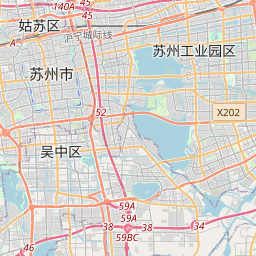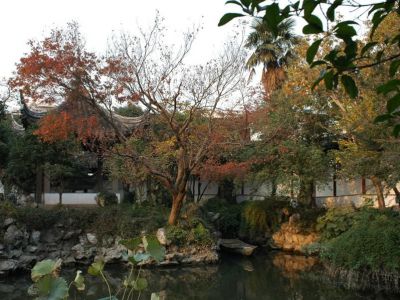
Central Suzhou (Self Guided), Suzhou
Downtown Suzhou is a mix of modern business hub and historic area where time seems to have frozen. Among the attractions worth visiting here are The Suzhou Police Museum, Dinghui Temple, Twin Pagodas, Xuanmiao Temple, and lively Guan Qian Street, all located within a walking distance from each other in the heart of the city.
How it works: Download the app "GPSmyCity: Walks in 1K+ Cities" from Apple App Store or Google Play Store to your mobile phone or tablet. The app turns your mobile device into a personal tour guide and its built-in GPS navigation functions guide you from one tour stop to next. The app works offline, so no data plan is needed when traveling abroad.
Central Suzhou Map






Guide Name: Central Suzhou
Guide Location: China » Suzhou (See other walking tours in Suzhou)
Guide Type: Self-guided Walking Tour (Sightseeing)
# of Attractions: 8
Tour Duration: 3 Hour(s)
Travel Distance: 6.0 Km or 3.7 Miles
Author: leticia
Sight(s) Featured in This Guide:
Guide Location: China » Suzhou (See other walking tours in Suzhou)
Guide Type: Self-guided Walking Tour (Sightseeing)
# of Attractions: 8
Tour Duration: 3 Hour(s)
Travel Distance: 6.0 Km or 3.7 Miles
Author: leticia
Sight(s) Featured in This Guide:
- Memorial to Wu Zixu
- Suzhou Police Museum
- Great Wave Pavilion (Canglang Pavilion)
- Yiyuan Garden
- Guan Qian Street
- Xuanmiao Temple
- Twin Pagodas
- Dinghui Temple
1) Memorial to Wu Zixu
The Memorial to Wu Zixu is situated across the river from the Suzhou Planning Exhibition Hall. The memorial is dedicated to Wu Zixu, a prominent Chinese scholar, military general and the most celebrated ancestor of people with the surname Wu. The memorial features a huge statue of Wu Zixu.
2) Suzhou Police Museum
Suzhou Police Museum is the oldest existing prison in the land. The museum explains Suzhou police history, and includes various exhibits with collections of republic police uniforms, equipment, documents, and photos.
3) Great Wave Pavilion (Canglang Pavilion)
The Great Wave Pavilion is located at 3 Cāng Làng Tíng Jie. It is recognized with other classical Suzhou gardens as a UNESCO World Heritage Site. The Great Wave Pavilion was built in 1044 CE by the Song Dynasty poet Su Shunqing (1008–1048), on the site of a pre-existing imperial flower garden c 960 CE. It is the oldest of the UNESCO gardens in Suzhou, keeping its original Song Dynasty layout. The 1.6 (ha) garden is divided into two main sections. The garden is sited on a branch of the Fengxi Stream which forms a lotus pond. The garden has 108 leaky windows each one with a unique design.
Sight description based on Wikipedia.
4) Yiyuan Garden
The Yiyuan Garden is a classical Chinese garden. It was built in the late Qing Dynasty in late 19th century, and is the most recently built Suzhou gardens.
The garden was originally a private garden built by Go Wenbin, an official of the early years of the Guangxu Reign of the late Qing Dynasty. It has been described as one of the most representative Suzhou gardens, comprising of a garden, a lotus pond, residences, artificial villages and ancestral halls. Because the garden incorporates all the elements of the various Suzhou gardens, it is sometimes regarded as an agglomeration of Suzhou's garden culture. Suzhou's garden culture.
The garden was originally a private garden built by Go Wenbin, an official of the early years of the Guangxu Reign of the late Qing Dynasty. It has been described as one of the most representative Suzhou gardens, comprising of a garden, a lotus pond, residences, artificial villages and ancestral halls. Because the garden incorporates all the elements of the various Suzhou gardens, it is sometimes regarded as an agglomeration of Suzhou's garden culture. Suzhou's garden culture.
Sight description based on Wikipedia.
5) Guan Qian Street (must see)
Guanqian Street is located in Suzhou city center, an area covering 0.52 square kilometers, the commercial part of the city.
The location of this 150-year-old street lying in front of the Xuanmiao Taoist temple explains its name, which means "before a temple". The street running 760 meters long, consists of the eastern, middle and western sections. The eastern part is filled with nice ancient buildings of historical significance. The middle is mainly the temple and fashionable shops occupy the western part.
There are hundreds of shops, restaurants, bars, stores and clubs in old fashioned structures surrounded by colorful signs and neon lights along the street.
An old laneway leads to the gate of the temple while the Guanqian pedestrian street lies just ahead of it.
The location of this 150-year-old street lying in front of the Xuanmiao Taoist temple explains its name, which means "before a temple". The street running 760 meters long, consists of the eastern, middle and western sections. The eastern part is filled with nice ancient buildings of historical significance. The middle is mainly the temple and fashionable shops occupy the western part.
There are hundreds of shops, restaurants, bars, stores and clubs in old fashioned structures surrounded by colorful signs and neon lights along the street.
An old laneway leads to the gate of the temple while the Guanqian pedestrian street lies just ahead of it.
Sight description based on Wikipedia.
6) Xuanmiao Temple
Xuanmiao Temple "Mysterious Sublimity Temple" or "Mysterious Essence Temple" is a prominent Taoist temple with a long history, located at the center of old Suzhou City.
The street along east-west direction in front of the temple is called Guanqian Street, a famed business pedestrian street in Suzhou. A lane called Gong Xiang along north-south direction leads directly to the gate.
Xuanmiao Temple was founded in Xianning 2nd year (AD 276), Western Jin Dynasty, and was initially named "Zhen Qing Dao Yuan". It was destroyed by wars in Southern Song Dynasty. It was rebuilt in Chunxi's years (1174–1189), and was renamed Xuanmiao Guan in 1264. In Qing Dynasty, due to the taboo against using the emperor Kangxi's name, Xuanye, the temple was renamed Yuanmiao Guan.
The street along east-west direction in front of the temple is called Guanqian Street, a famed business pedestrian street in Suzhou. A lane called Gong Xiang along north-south direction leads directly to the gate.
Xuanmiao Temple was founded in Xianning 2nd year (AD 276), Western Jin Dynasty, and was initially named "Zhen Qing Dao Yuan". It was destroyed by wars in Southern Song Dynasty. It was rebuilt in Chunxi's years (1174–1189), and was renamed Xuanmiao Guan in 1264. In Qing Dynasty, due to the taboo against using the emperor Kangxi's name, Xuanye, the temple was renamed Yuanmiao Guan.
Sight description based on Wikipedia.
7) Twin Pagodas
Twin Pagodas is a prominent city landmark, located in the Dinghui Temple Lane. These two wooden pagodas are octagonal in shape and feature seven levels. Near the pagodas you will also discover the Ocean Institute temple ruins, which date back to AD 982.
8) Dinghui Temple
The Dinghui Temple was erected during the Eastern Han Dynasty and is clearly the largest temple on the hill. Originally famous as Puji Temple, the special landmark features 98 various halls and 18 additional temples nearby. The most prominent structures around the complex: Daxiongbaodian Hall and Huayan Pavilion.
Walking Tours in Suzhou, China
Create Your Own Walk in Suzhou
Creating your own self-guided walk in Suzhou is easy and fun. Choose the city attractions that you want to see and a walk route map will be created just for you. You can even set your hotel as the start point of the walk.
Suzhou Introduction Walking Tour
"Above there is heaven; below there is Suzhou (and Hangzhou)." Often spoken of in conjunction with Hangzhou, another picturesque city in China, Suzhou is located in the eastern part of the country and is colloquially referred to as the "Water Town of the East," renowned for its waterways and classical gardens, together creating an idyllic setting.
As the cradle of Wu... view more
Tour Duration: 2 Hour(s)
Travel Distance: 4.6 Km or 2.9 Miles
As the cradle of Wu... view more
Tour Duration: 2 Hour(s)
Travel Distance: 4.6 Km or 2.9 Miles
The Most Popular Cities
/ view all









